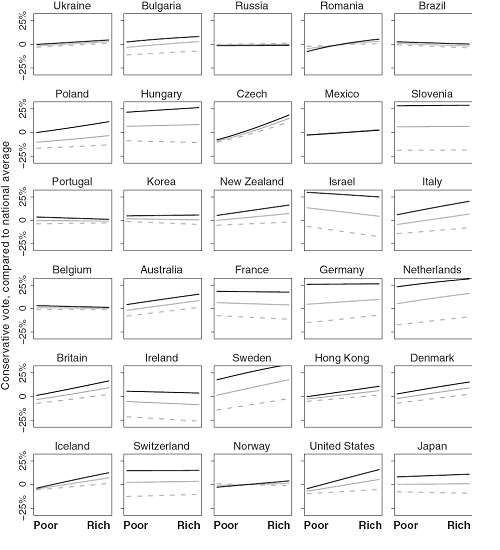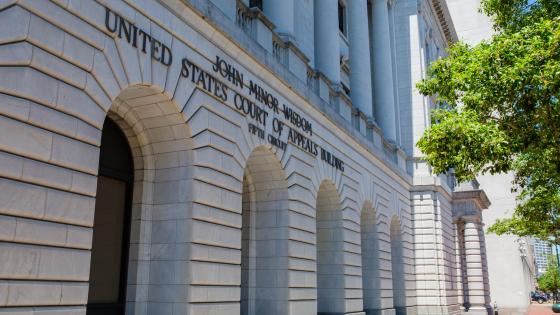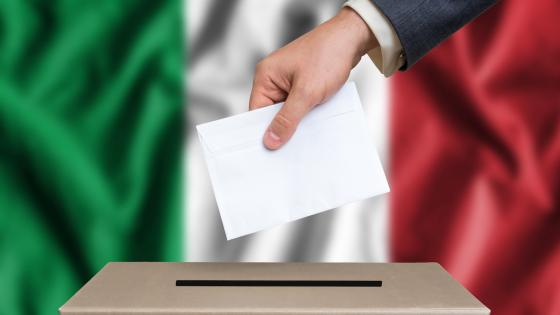Barack Obama attracted attention recently by describing small-town Americans who were “bitter” at economic prospects who “cling to guns or religion’’ in frustration. This statement, made during the height of the Democratic nomination battle, has received a lot of attention, but it represents a common view. For example, Senator Jim Webb of Virginia wrote, “Working Americans have been repeatedly seduced at the polls by emotional issues such as the predictable mantra of ‘God, guns, gays, abortion and the flag’ while their way of life shifted ineluctably beneath their feet.’’ And this perspective is not limited to Democrats. For example, conservative columnist David Brooks associates political preference with cultural values that are modern and upscale (“sun-dried tomato concoctions”) or more traditional (“meatloaf platters”).
All these claims fit generally into the idea of religion as the opiate of the masses, the idea that social issues distract lower-income voters from their natural economic interests. But there is an opposite view, associated with political scientist Ronald Ingelhart, of post-materialism—the idea that, as people and societies get richer, their concerns shift from mundane bread-and-butter issues to cultural and spiritual concerns.
Which story better describes how Americans vote? Who are the values voters? Are they the poor (as implied by the “opiate of the masses’’ storyline) or the rich (as would be predicted by “post-materialism”)?
Case studies are interesting but do not resolve the question. Thomas Frank described how Kansas is full of socially conservative Republicans at all income levels. But then there is south Texas, whose low-income Latinos are socially conservative on many issues but vote for Democrats. Manhattan’s upper west side remains strongly Democratic despite its steadily increasing income level, but the suburbs of Dallas are full of high-income conservative Republicans.
There are many ways of looking at social class, attitudes, and voting. We’ll take a demographic approach and compare religious to secular voters.
Regular churchgoers are about 15% more likely than non-attendees to vote Republican. Perhaps surprisingly, this big religion gap did not show up until 1992, when Bill Clinton ran against George H. W. Bush, as we show in Figure 1.
Back in 1980, Jerry Falwell’s Moral Majority and other Religious Right organizations played a prominent role in rallying support for Ronald Reagan and other Republican candidates. But the gap between religious and non-religious in voting was actually less for Ronald Reagan—in both 1980 and 1984—than for Gerald Ford in 1976. As Glaeser and Ward (2006) point out, the recent political divisions associated with religious belief coincide with the geographic pattern of richer states supporting the Democrats and poorer states going Republican.
Figure 1. Difference in probability of voting for the Republican candidate for president, comparing people who went to church at least once per week to nonattenders. Nothing much was happening until 1992, when all of a sudden George H. W. Bush received 20% more of the vote among religious than among the nonreligious.
So religion matters. For whom does it matter? Does it matter for the frustrated masses, seduced by emotional issues, or for the less economically-pressed elites? We can answer the question by measuring the religious/secular gap among voters at different income levels.
Figure 2. Support for George W. Bush, as a function of income, plotted separately for frequent church attenders, moderate attenders, and non-attenders. The difference between rich and poor is large for religious people but disappears among the non-religious.
The difference in Republican support, comparing regular religious attendees to non-attendees, is huge for rich voters but low among the poor; see Figure 2. This result—that church attendance predicts voting more for the rich than the poor—is consistent with the finding of Ansolabehere, Rodden, and Snyder (2007) that “low-income Americans are significantly less inclined to vote based on moral values than are high-income groups.” They find the impact of economic issues on voting is larger for regular churchgoers, residents of Republican-leaning states, and rural voters than for non-churchgoers, residents of Democratic states, and urban or suburban voters.
To connect to Figure 2: the line for regular churchgoers is steep, while the line for non-attenders is flat. Thus, income predicts how you vote—if you are religious. We had earlier found that income predicted voting more in poor states than in rich states (Gelman, Shor, Bafumi, and Park, 2007). This again fits the story of post-materialism, that economic concerns are more important in poorer areas, with social and religious issues mattering more among the rich.
The United States is far from unique in having religion as a political division. Religious and secular voters differ no more in America than in France, Germany, Sweden, and many other European countries, consistent with the post-materialist notion that people in richer countries have the luxury of voting on social issues. Figure 3 tells the story.
Huber and Stanig (2007) and Huber (2007) noted that, within each country, the differences between rich and poor voting tend to be larger among religious voters; however, the differences between rich and poor—both in their voting patterns and in the size of the religion gap—are larger here than in most other countries, a finding also consistent with post-materialism. Incomes are more unequal in the United States than in other rich countries today, and so it makes sense that rich and poor vote more differently. And, indeed, the Democratic and Republican parties are farther apart on issues of economic redistribution than are left and right parties in most European countries.
Religious Americans are more Republican than secular Americans, but the difference between them is mostly among the middle class and rich—the “post-materialist” values voters. The evidence does not support the idea that lower-income Americans are voting based on “God, guns, and gays.”
Figure 3. For each of thirty countries (ordered by per-capita GDP), estimated vote for conservative parties by income and religious attendance. In each plot, the solid, light, and dotted lines show the estimates for frequent religious attenders, occasional attenders, and nonattenders. With only a few exceptions, churchgoers and higher-income people are much more likely to vote for conservative parties. The curve show logistic regression fits, which can be misleading because the actual pattern is not always smooth; for example, in some countries, middle-income people vote more conservatively than the rich or the poor. The purpose of this figure is to quickly show overall patterns of richer or more religious people voting conservatively in different countries.
References
This article is based on material in some of the material in chapters 6 and 7 of the forthcoming book, Red State, Blue State, Rich State, Poor State: Why Americans Vote the Way They Do, by Andrew Gelman, David Park, Boris Shor, Joseph Bafumi, and Jeronimo Cortina. Related material appears at http://www.stat.columbia.edu/~gelman/blog/
Our analyses used U.S. poll data from the National Election Study and the Annenberg Election Survey and international data from the Comparative Study of Electoral Systems. Self-reports of religious attendance can not necessarily be trusted (see Haraway, Marler, and Chaves, 1993, along with the follow-ups cited here. Nonetheless, we follow the usual practice in social science and work with the survey responses, assuming that people who say they attend church weekly are more religious than those who say they do not attend, whatever their actual practices.
Here are the other references cited, in order of appearance:
Webb, Jim (2006). Class struggle: American workers have a chance to be heard. Wall Street Journal, 15 November.
Brooks, David (2001). One nation, slightly divisible. Atlantic Monthly, December.
Inglehart, Ronald (1971). The silent revolution in post-industrial societies. American Political Science Review 65, 991-1017.
Frank, Thomas (2005). What’s the Matter With Kansas? How Conservatives Won the Heart of America. New York: Macmillan.
Shapiro, Walter (2005). What’s the matter with Central Park West? Atlantic Monthly, March.
Glaeser, Edward, and Ward, Bryce (2006). Myths and realities of American political geography. Unpublished paper.
Ansolabehere, Stephen, Rodden, Jonathan, and Snyder, James (2006). Purple America. Journal of Economic Perspectives 20, 97-118.
Gelman, Andrew, Shor, Boris, Bafumi, Joseph, and Park, David (2007). Rich state, poor state, red state, blue state: what's the matter with Connecticut? Quarterly Journal of Political Science 2, 345-367.
Huber, John, and Stanig, Piero (2007). Why do the poor support right-wing parties? A cross-national analysis. Unpublished paper.
Huber, John (2007). Religious belief, religious participation, and social policy attitudes across countries. Unpublished paper.







